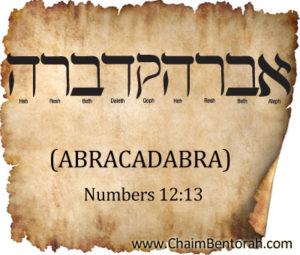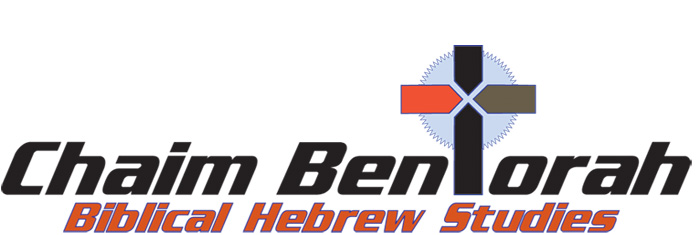HEBREW WORD STUDY – ABRACADABRA – אברה קדברה
Numbers 12:13: “And Moses cried to Jehovah saying: “Oh, my God, I beg you give healing to her, I beseech you.”
 Imagine the next time you pray for someone to be healed, you lay your hands on that person and say “Abracadabra.” This is a term which has crossed over into English usage, picked up by showmen who observed rabbis performing healings who used this word as a sort of incantation. The word Abra-Kadabra is a Hebrew word and contains bara which means to create. The numerical value of the remaining letters add up to 26 is the numerical value for YHVH – The name of God. You see the ancient Jews believed that healing came when you invoked the name of God. In fact, healers were known as Baal Shems (Masters of the Name). But since the name was so sacred and no one knew it’s correct pronunciation, they could not invoke it but they devised a phrase which in its Gematria invokes the name of God. The phrase Abracadadabra literally means: “I will create as I speak.” The rabbis of the past often recited these words in an attempt to emulate the creation through the speech of God. It was believed this is the word that God spoke when he created the world. I’m not making this up.
Imagine the next time you pray for someone to be healed, you lay your hands on that person and say “Abracadabra.” This is a term which has crossed over into English usage, picked up by showmen who observed rabbis performing healings who used this word as a sort of incantation. The word Abra-Kadabra is a Hebrew word and contains bara which means to create. The numerical value of the remaining letters add up to 26 is the numerical value for YHVH – The name of God. You see the ancient Jews believed that healing came when you invoked the name of God. In fact, healers were known as Baal Shems (Masters of the Name). But since the name was so sacred and no one knew it’s correct pronunciation, they could not invoke it but they devised a phrase which in its Gematria invokes the name of God. The phrase Abracadadabra literally means: “I will create as I speak.” The rabbis of the past often recited these words in an attempt to emulate the creation through the speech of God. It was believed this is the word that God spoke when he created the world. I’m not making this up.
Divine healing in Jewish history focused on two practices, often working jointly together. The physicians/priests who focused their methods on diet and the use of various herbs and essential oils and those who practiced healing methods that addressed the spiritual. The tradition of divine healing, within the church, was adopted from Jewish tradition and the church, like in Jewish tradition once involved the use physicians who supplemented prayer with diet and the use of essential oils and herbs. Encouraging someone to not see a physician or take medication does not align with the church and Jewish tradition of healing.
Did You know that this study is featured in Chaim Bentorah’s 365-Day Devotional Book? Treasures Of The Deep?
Click here for a special offer!
Physical ailments were thought to be only a manifestation on the physical level of an illness that was simultaneously taking place on other levels of the soul. Once the soul was healed the physical healing would follow, sometimes through the medical skills of a physician or sometimes spontaneously. The important thing is that there must first be a healing of the soul.
Prayer has long been considered an important healing tool. Having a tzaddik – righteous person fervently pray for the health of someone was considered effective. No, I am not quoting James 5:16, I am quoting the Talmud.
Numbers 12:13 shows Moses as a righteous man praying for healing. What does he say? The first thing to notice is that he did not sa’ek or invoke the name of God. He only repeated the Hebrew words, Na’ raphe, to God. He literally chanted: “I pray healing, I pray healing.” Miriam was not immediately healed, but she was shut up out of the camp for seven days. This was seven days of repentance. During that time she was attended by the Levi priest who served as physician and, she went through a process of repentance using various calming fragrances to relaxed her physically so she could focus and concentrate on her prayers of repentance and only then was she healed.
When you pray for healing there is nothing wrong in repeating your prayer. Moses did it with “Na rapha,” (I pray healing, I pray healing). But there is nothing magical in the chant, it is just a tool or a discipline to help you focus and concentrate on God, to bring the soul and body into alignment with your spirit. Don’t stoop to the level of a Shaman thinking your words are going to motivate God. Not even abrakadabra, will bring God’s healing, but your focus on Him, your submission to Him and your love for Him will, as James said: “The fervent prayer of a righteous man accomplishes much.”








Recent Comments